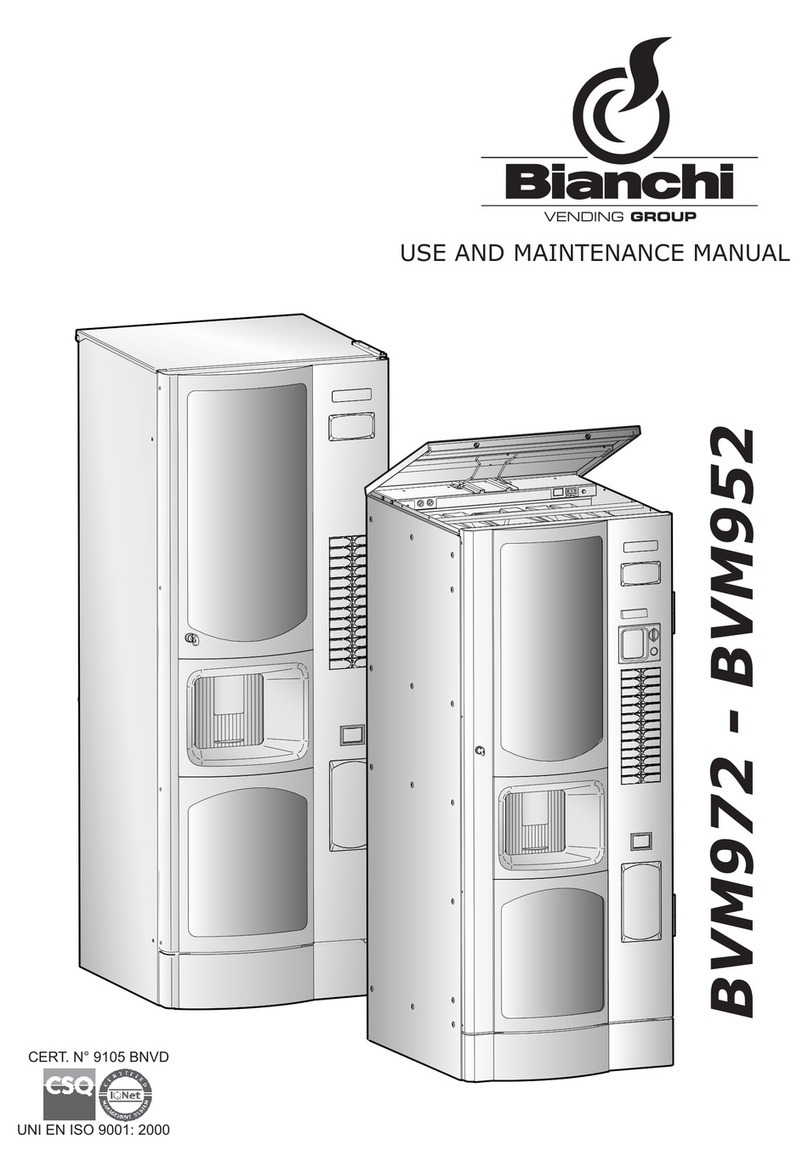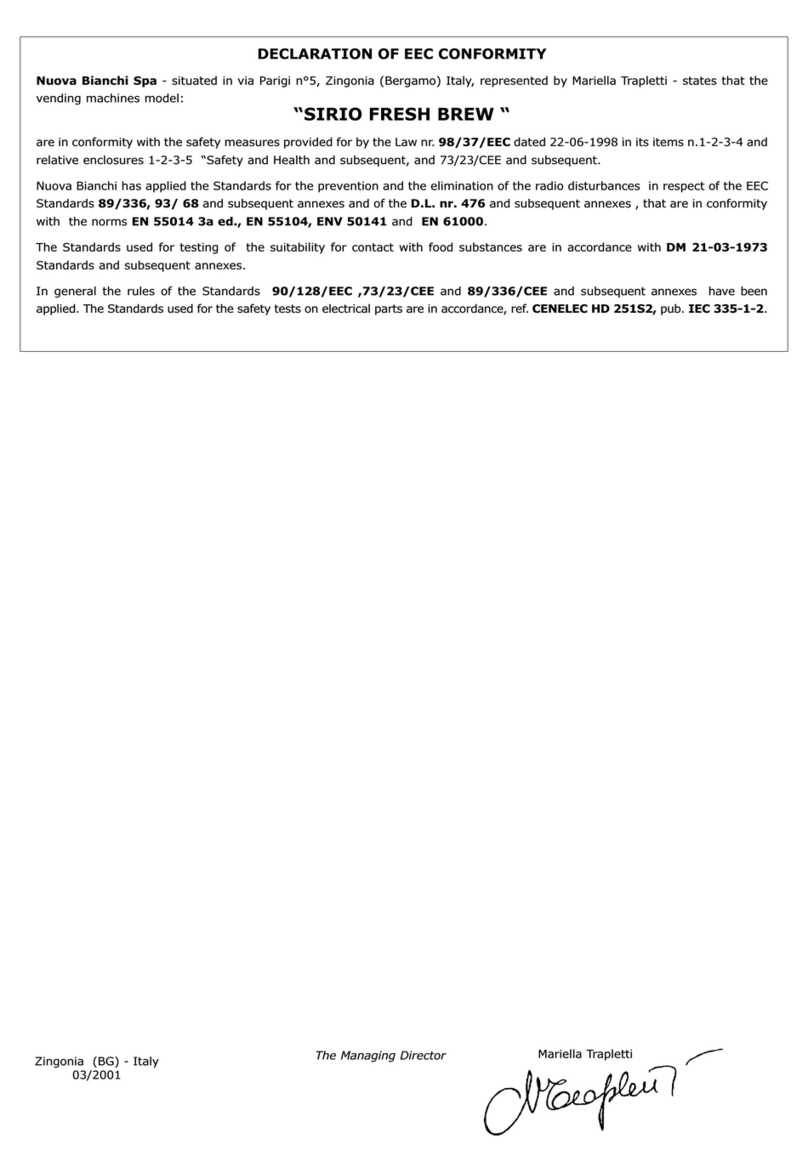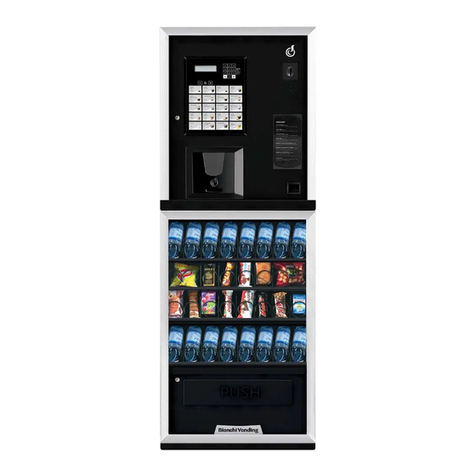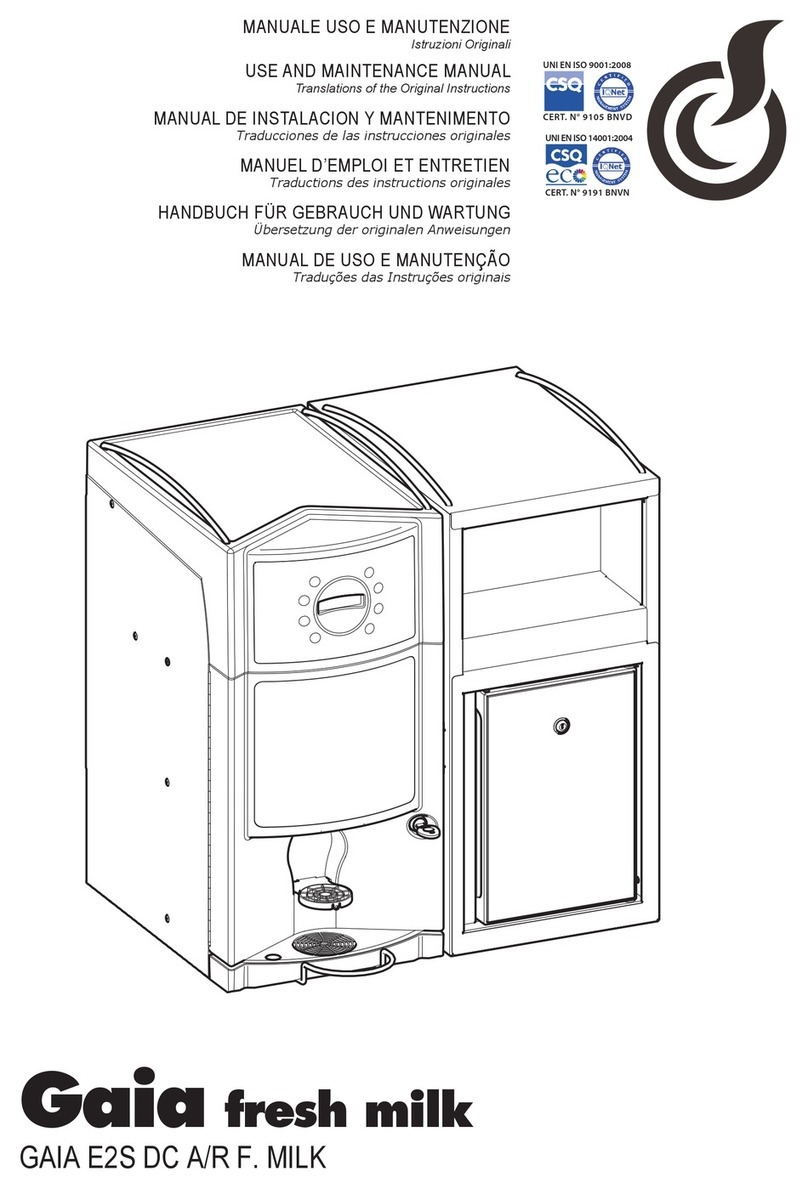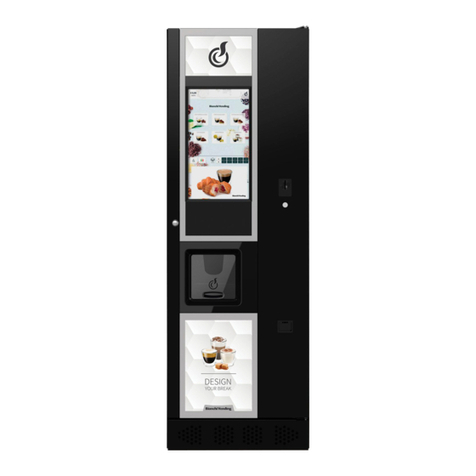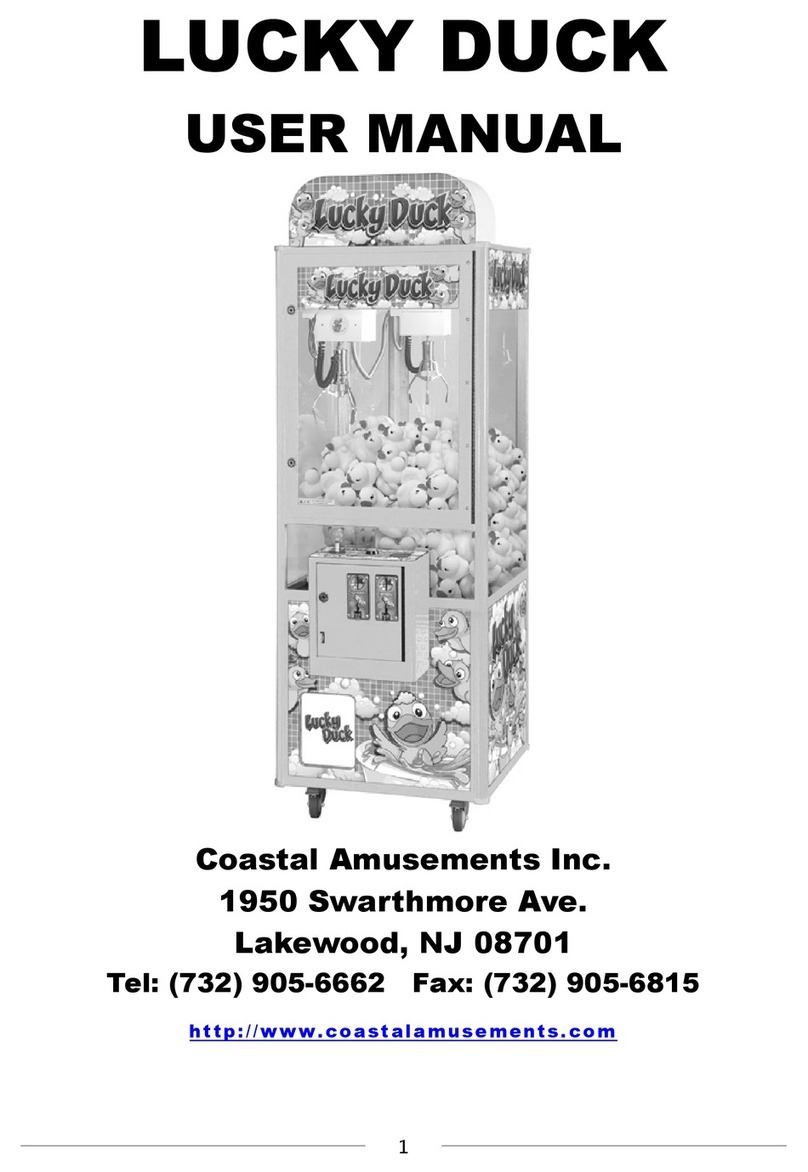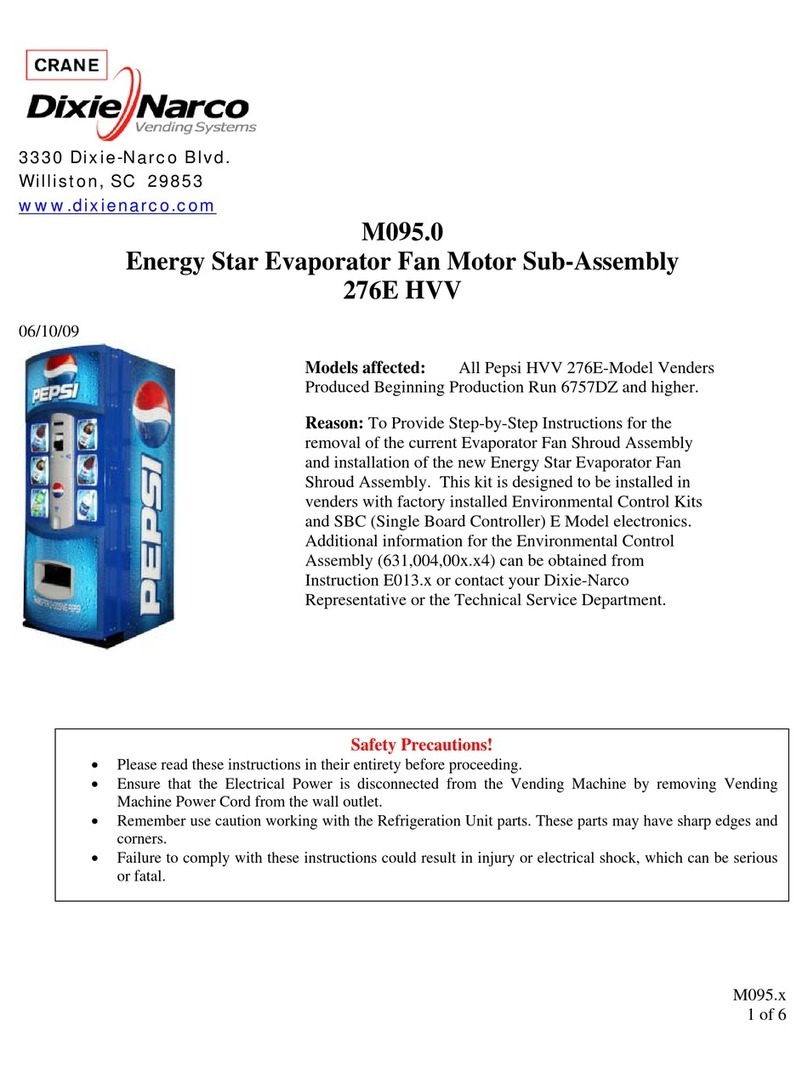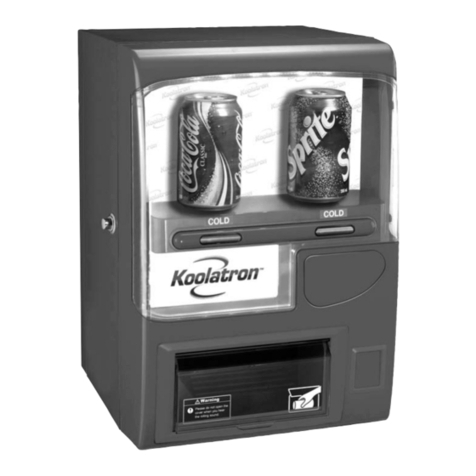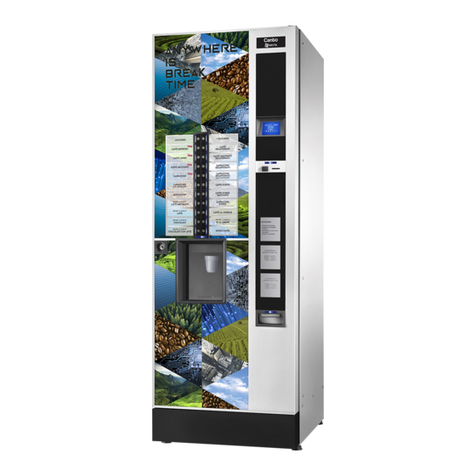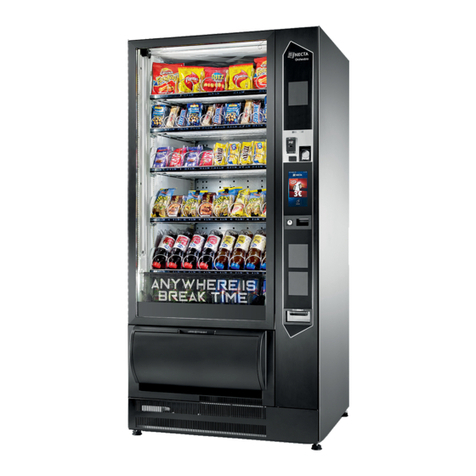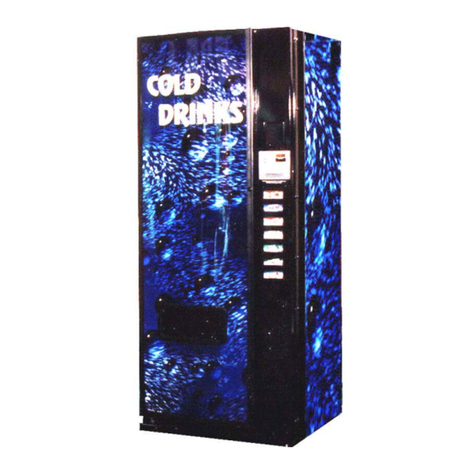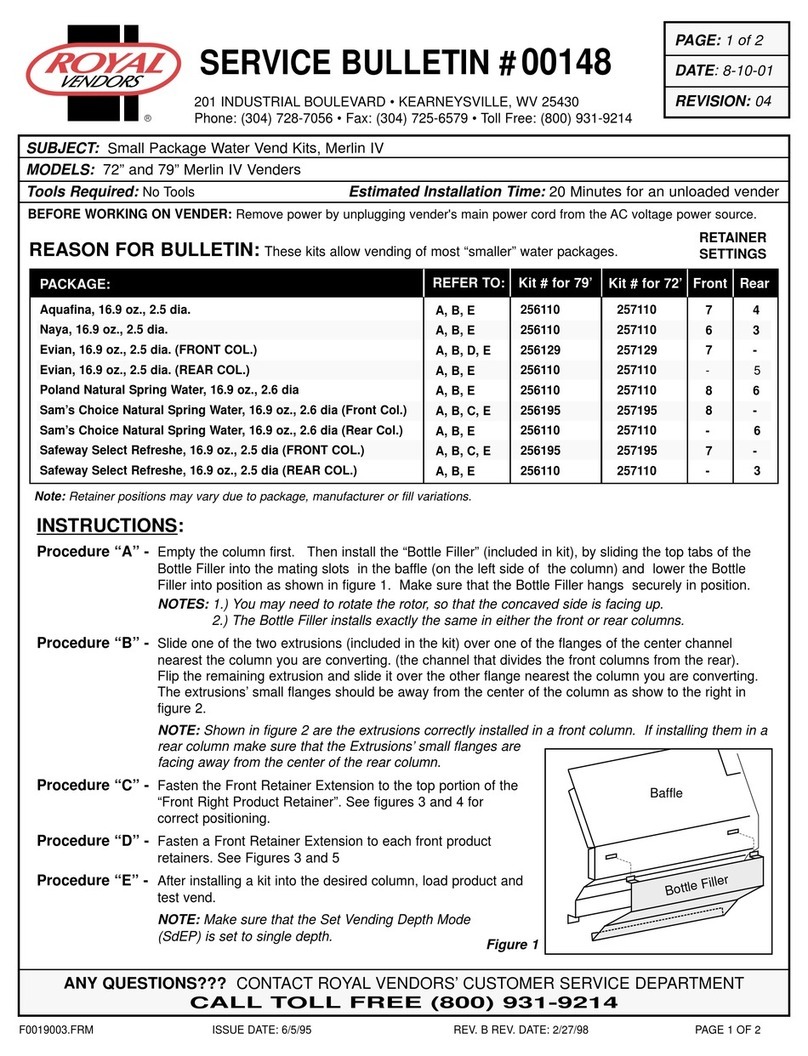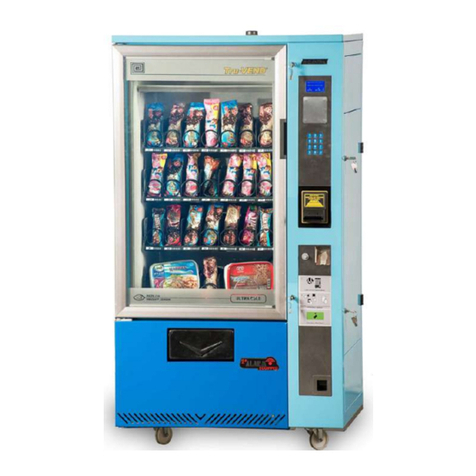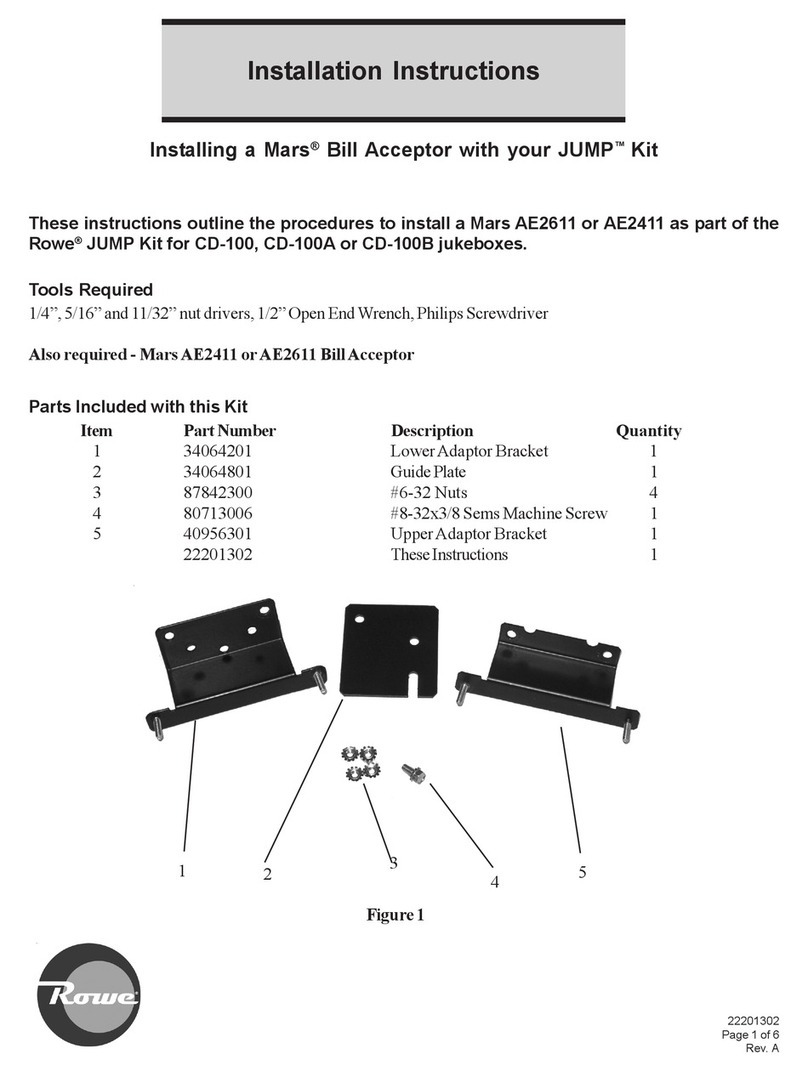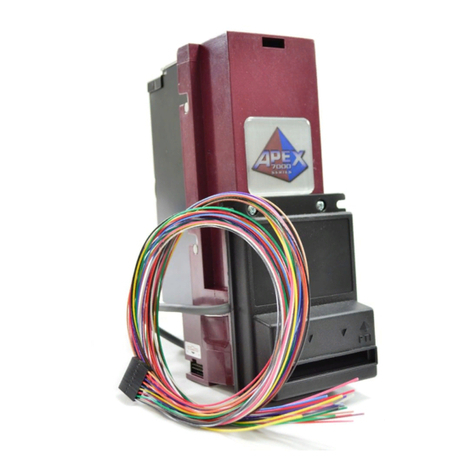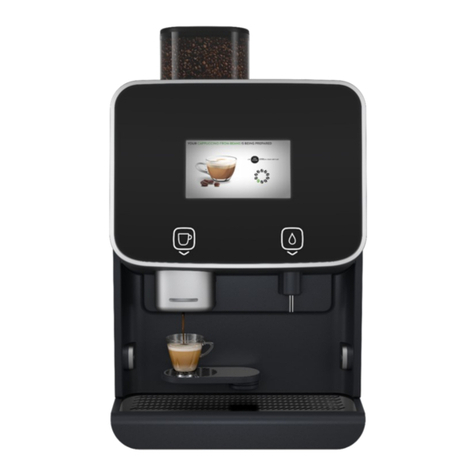
8
ITALIANO
3.4 Ricevimento
All’atto del ricevimento del distributore automatico occorre controllare che
lo stesso non abbia subito danni durante il trasporto.
Se si dovessero notare danni di qualsiasi natura si faccia immediatamente
reclamo al trasportatore.
Allanedeltrasportol’imballodeverisultareintegro,valeadirenon
deve:
– Presentare ammaccature, segni di urti, deformazioni o rotture dell’invo-
lucro contenitore.
– Presentare zone bagnate o segni che possano condurre a supporre che
l’involucro sia stato esposto alla pioggia, al gelo o al calore.
– Presentare segni di manomissione.
3.5 Disimballaggio
– Liberare il distributore dal suo imballo, tagliando il lm protettivo in cui
è avvolto, lungo uno degli angolari di protezione.
– Togliere la chiave dal vano erogazione (Fig.3.3).
Aprire la porta del distributore e togliere il nastro adesivo dai componenti
di seguito elencati:
Copertura vano gettoniere/scheda tastiera
Contenitori prodotti.
I materiali di imballaggio non devono essere lasciati alla portata di per-
sone estranee, perchè potenziali fonti di inquinamento per l’ambiente.
Perlosmaltimentoafdarsiadaziendeautorizzate.
4.0 INSTALLAZIONE
4.1 Posizionamento
– Come già specicato nel paragrafo “III Norme per la sicurezza”, il distri-
butore automatico non è idoneo per essere installato all’esterno, deve
essere collocato in locali asciutti, con temperature che non scendano mai
sotto 1°C, non può essere installato in locali dove vengano utilizzati getti
di acqua per la pulizia (es. grandi cucine ...).
– Se posizionato vicino ad una parete, lo schienale deve avere una distanza
minima di 5 cm dalla stessa (Fig.4.1), per permettere la regolare venti-
lazione. In nessun caso coprire il distributore con panni o similari.
ATTENZIONE! Non posizionare l’apparecchio vicino ad oggetti inam-
mabili, rispettando una distanza minima di sicurezza di 30 cm.
La Bianchi Industry declina ogni responsabilità per inconvenienti dovuti
all’inosservanza delle norme di posizionamento.
Se l’installazione avviene in corridoi di evacuazione di sicurezza assicurarsi
che con il distributore a porta aperta rimanga comunque spazio sufciente
al passaggio (Fig.4.1).
Per evitare che il pavimento si sporchi, causa cadute accidentali di prodotti,
utilizzare, se necessario, sotto il distributore, una protezione sufcientemente
larga a coprire il raggio d’azione dello stesso.
4.2 Collegamento rete elettrica
Accertarsi che l’alimentazione di rete corrisponda a quella indicata sul distri-
butore.
All’interno del distributore è presente 1 fusibile di protezione,
ubicato sulla scheda di alimentazione: T3,15A.
Si consiglia di controllare che:
– La tensione di rete di 230 V non abbia uno scostamento maggiore del ±
10%.
– La linea di alimentazione sia adatta a sopportare il carico del distributore
automatico.
– Utilizzare un sistema di protezione tecnico-differenziale.
– Posizionare l’apparecchio in modo tale che la spina rimanga accessibile.
L’apparecchio deve essere collegato ad una presa di terra in ottemperanza
alle vigenti norme.
Vericare in tal senso il collegamento del lo di terra dell’impianto afnchè sia
efciente e risponda alle normative nazionali ed europee di sicurezza elettrica.
Se necessario richiedere l’intervento di personale professionalmente quali-
cato per la verica dell’impianto.
– Il distributore è dotato di cavo di alimentazione H05VV-F 3x1,5mm², con
spina CEE 7/7 (Spina NBR 14136:2001 – Spina Iram 2073 10A)* (Fig.4.2).
– Le prese non compatibili con la spina dell’apparecchio devono essere
sostituite (Fig.4.3).
– E’ vietato l’uso di prolunghe, adattatori e/o prese multiple.
La Bianchi Industry declina ogni responsabilità per danni causati dall’inos-
servanza parziale o totale delle suddette avvertenze.
Se il cavo di alimentazione dovesse risultare danneggiato, scollegare imme-
diatamente dall’alimentazione elettrica
La sostituzione dei cavi di alimentazione deve essere effettuata
da personale qualicato
*Versioninazionalispeciche
4.3 Messa in servizio
Il distributore è dotato di interruttore di sicurezza (Fig.4.4) che toglie tensio-
ne a tutti gli utilizzatori, ogni qualvolta viene aperta la porta (vedi schema
elettrico).
In caso di necessità, quindi, aprire la porta o scollegare la spina dalla presa
dell’impianto.
4.4 Installazione
4.4.1 Riempimento circuito idraulico
L’apparecchio provvede in maniera automatica al riempimento del circuito
idraulico.
La sequenza delle operazioni sarà:
– Accensione distributore
- Modalita’ prima installazione
Al primo avviamento della macchina verrà effettuata una auto-installazione
che riempirà la caldaia espresso erogando 300cc
– Al termine verrà richiesto l’inserimen-
to della data.
– Al termine del riempimento (Fig.4.5),
effettuare dei lavaggi del gruppo
mixer per riempire tutti i circuiti e
rimuovere eventuali residui dalla caldaia.
Prima di dare tensione, accertarsi di avere collegato il distributore
alla rete idrica e di avere provveduto ad aprire il rubinetto dell’acqua.
Effettuare la prima installazione per distributori con serbatoio autonomo
rimuovendol’eventualeltrodalserbatoiostesso.
4.4.2 Lavaggio parti a contatto con alimenti
A distributore acceso effettuare dei lavaggi dei miscelatori premendo i pulsanti
secondo quanto riportato alle funzioni di servizio al ne di eliminare ogni
possibile residuo di sporco dalla caldaia caffè e caldaia solubili.
– Lavarsi accuratamente le mani
– Preparare una soluzione disinfettante antibatterica a base di cloro (pro-
dotti reperibili presso negozi farmaceutici) seguendo scrupolosamente le
indicazioni riportate sul prodotto stesso.
- Prima di rimuovere il contenitore provvedere ad abbassare lo
sportellino per evitare una fuoriuscita accidentale del prodotto solubile
in esso contenuto (g. 4.6).
– Rimuovere tutti i contenitori prodotti dal distributore (Fig.4.7).
– Rimuovere dagli stessi i coperchi e gli scivoli prodotti (Fig.4.8). Immergere
tutto nella soluzione precedentemente preparata.
– Rimuovere tutti i convogliatori polveri, imbuti acqua, camere e ventole
di frullatura, tubi al silicone ed immergere anche questi particolari nella
soluzione preparata (Fig.4.9).
– Con un panno imbevuto della soluzione pulire anche le basi dei frullatori
(Fig.4.10).
Modalita’ prima auto-installazione
Per Mono caldaia Espresso:
All’accensione del distributore l’acqua riempie l’airbreack.
Quando il galleggiante sarà in posizione alta la macchina inizierà un carico
automatico di acqua che continuerà nchè il ventolino non avrà contato il
passaggio di 300cc di acqua (verrà quindi erogata acqua tramite l’elettro-
valvola caffè).
La procedura verrà eseguita con la resistenza spenta.
Al termine verrà richiesto l’inserimento della data.
Per Caldaia Solubile :
All’ accensione del distributore si riempie la caldaia in polisulfone no al rag-
giungimento livello massimo della sonda; parte la pompa per 5 sec., richiesto
inserimento della data, inizia il riscaldamento.
Restano sotto tensione, la morsettiera del cavo di alimentazione.
– Per alcune operazioni è però necessario operare con porta aperta, ma
distributore attivo.
E’ possibile, per il tecnico installatore, operare in questo modo, inserendo
la speciale chiavetta in plastica (riarmo clixon) (fornita in dotazione nel
corredo del distributore automatico) nell’interruttore porta, ruotandola di
90° (Fig.4.4).
L’apertura e l’eventuale attivazione a porta aperta del distributore, devono
essereafdateesclusivamenteapersonaleautorizzatoall’esecuzionedi
queste operazioni.
Non lasciare incustodito il distributore aperto.
La chiave di esclusione delle sicurezze è custodita sotto l’esclusiva respon-
sabilità del tecnico installatore.
Ad ogni accensione del distributore avviene un ciclo di diagnosi per vericare la
posizione delle parti in movimento e la presenza dell’acqua e di alcuni prodotti.
ATTENZIONE
Il distributore non può essere installato in locali denominati “cucine
industriali”.
4.3.1 Allacciamento alla rete idrica
Adottare solo ed esclusivamente il tubo in dotazione rispondente alla nor-
mativa “EN 61770” ed assicurarsi che la rete abbia una pressione compresa
tra 0,5 e 6,5 bar (in caso contrario utilizzare una pompa o un riduttore di
pressione, a seconda del caso).
16 / 02 / 2017




















